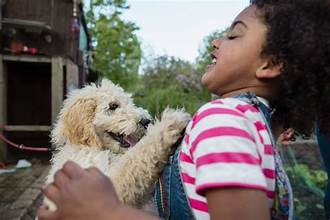Dogs often jump on people to express excitement or seek attention, but this behavior can be problematic, especially for children, elderly individuals, or guests who may find it overwhelming. Training your dog not to jump on people is a goal that requires consistent effort and positive reinforcement techniques. Here is a step-by-step guide to help you teach your dog good manners:
Step 1: Understand Why Your Dog Jumps
Dogs jump because they want attention or are overly excited. Addressing the root cause can redirect their energy and enthusiasm into more appropriate behaviors. Remember that your dog is not trying to misbehave—it is simply doing what comes naturally to it.

Step 2: Manage the Environment
Before beginning training, take steps to prevent jumping:
- Use a leash: Keep your dog on a leash when guests arrive to maintain control.
- Create a barrier: Use baby gates or keep your dog in a separate area until they are calmer.
- Remove triggers: Discourage overly excited greetings that make your dog more likely to jump.
Step 3: Teach an Alternative Behavior
Teaching your dog what to do instead of jumping is essential.
The Sit Command
- Start in a quiet space: Use treats and a calm environment to practice the “sit” command.
- Reward calm behavior: When your dog sits, immediately offer praise and a treat.
- Gradually add distractions: Practice the sit command with increased distractions, like new people or environments.
- Reinforce consistently: Whenever your dog approaches someone, ask them to sit and reward them for staying seated.
The Off Command
- Interrupt jumping: When your dog jumps, say “off” in a firm but calm voice.
- Reward four paws on the floor: The moment all four paws are on the ground, offer a treat and praise.
- Practice regularly: Repeat this process every time they jump to reinforce the idea that keeping paws on the floor earns rewards.
Step 4: Use Positive Reinforcement
Positive reinforcement is key to training success. Whenever your dog displays desired behaviors, such as sitting calmly instead of jumping, reward them with the following:
- Treats: Use small, high-value treats.
- Praise: Verbal praise like “Good dog!” reinforces their good behavior.
- Attention: Petting and affection can be powerful rewards.
Step 5: Ignore Jumping Behavior
Sometimes, dogs jump because even adverse reactions (like pushing them away) feel rewarding. To discourage jumping:
- Turn away: Fold your arms and turn your back when your dog jumps.
- Avoid eye contact: Don’t engage until your dog has all four paws on the floor.
- Reward calmness: When they stop jumping, turn back and reward their calm behavior.

Step 6: Train Guests to Help
Consistency is crucial. Inform family members and visitors about the training plan:
- Ask guests to ignore jumping: Request they turn away and avoid engaging until your dog is calm.
- Provide treats: Hand visitors treats to reward your dog for sitting or staying calm.
- Stay consistent: Ensure everyone follows the same rules to avoid confusion for your dog.
Step 7: Be Patient and Persistent
Training takes time and repetition. Here are some tips to keep in mind:
- Stay consistent: Always reinforce the same rules and behaviors.
- Keep sessions short: Train in 5-10 minute intervals to keep your dog’s attention.
- Celebrate small wins: Progress may be slow, but every step forward is successful.
Final Thoughts
Teaching your dog not to jump on people improves their manners and ensures a more enjoyable experience for everyone they meet. By using positive reinforcement, consistent commands, and managing their environment, you’ll help your dog learn to greet people politely. With patience and practice, your furry friend will soon be a model of good behavior.




